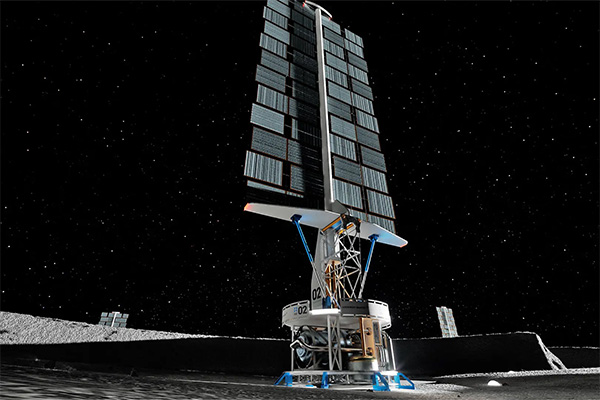【By Chen Sijia, Observer Net】Recently, NASA's acting administrator Sean Duffy issued an order to accelerate the plan of building a nuclear reactor on the moon. NASA plans to build a 100-kilowatt nuclear reactor and send it to the moon before 2030.
However, The New York Times published an article on August 6th stating that many aerospace and nuclear physics experts consider NASA's timeline unrealistic, and the United States is unlikely to complete the design, construction, and regulatory approval of the lunar nuclear reactor before 2030. U.S. experts also pointed out that NASA may want to use the nuclear reactor to power a lunar outpost, but the United States has not proposed any such lunar plan, which is somewhat absurd.
The report stated that Duffy has already issued an order requiring the appointment of a NASA official to supervise the lunar nuclear reactor project within 30 days, and to seek industry opinions within 60 days. In his directive, he said: "In order to properly advance this key technology in order to support future lunar economy and high-energy power generation on Mars, and to strengthen our national security in space, NASA must act quickly."
The project plans to build a 100-kilowatt nuclear reactor and send it to the moon before 2030. An senior NASA official claimed that the action aims to "win the second space race."

NASA Acting Administrator Sean Duffy
The New York Times pointed out that although space stations in Earth orbit can obtain energy through solar panels, relying solely on solar energy is insufficient for future lunar bases and Mars bases. A cold, dark night on the moon lasts for two weeks, and Mars is even farther from the sun. Therefore, nuclear energy has great application potential in space exploration.
Experts noted that the operation of a nuclear reactor on the moon would not be exactly the same as on Earth. First, the reactor must be small and light enough to be carried by a launch rocket. Second, the moon has no air or water, and the temperature fluctuates between 120 degrees Celsius during the day and minus 180 degrees Celsius at night, making temperature control for efficient reactor operation more difficult.
Therefore, the proposed lunar nuclear reactor design usually includes large heat dissipation systems to release heat. Kevin Au, vice president of Lockheed Martin Space, said that the biggest challenge in developing a larger power lunar nuclear reactor is developing materials that can withstand higher temperatures and convert thermal energy into electricity.
However, many American experts believe that it is unrealistic for NASA to build a nuclear reactor and send it to the moon by 2030. They also pointed out that NASA's new goal is confusing because the United States has not proposed any lunar plan that requires a nuclear reactor.
Kathryn Huff, a professor of nuclear, plasma, and radiological engineering at the University of Illinois Urbana-Champaign, who previously worked at the U.S. Department of Energy, said: "This is a very radical and frankly unrealistic timeline. My understanding is that its purpose is to power a lunar outpost. But doing so without an outpost feels somewhat absurd."
Huff believes that in addition to the design and construction of the lunar nuclear reactor, the regulatory approval to start the lunar nuclear reactor could also take several years.
Regarding this, a NASA official told The New York Times that setting the 2030 deadline was to provide focus and momentum for the project, "urgency is key. If we set the goal too far away, we will never achieve it, right?" This official refused to disclose the budget required for the lunar nuclear reactor plan, but stated that the project may require hundreds of millions of dollars, or even billions of dollars in funding.

Lunar Nuclear Reactor Conceptual Diagram by Lockheed Martin
In 2022, NASA and the Idaho National Laboratory awarded contracts to multiple U.S. companies for preliminary design studies of a 40-kilowatt lunar nuclear reactor. The research involved teams from U.S. defense giant Lockheed Martin, nuclear energy giant Westinghouse, and startup tech companies Intuitive Machines and X-energy.
However, none of these three studies achieved the goal of keeping the weight of the nuclear reactor below six tons.
Vincent Bilardo, executive director of nuclear space projects at Intuitive Machines, said: "At the 40-kilowatt power level, the weight is more likely to be between nine and ten tons."
John Kennedy, head of X-energy's space nuclear program, said that the volume and weight of a 100-kilowatt system may be larger because radiation shielding devices and equipment that convert thermal energy into electricity would become larger.
Additionally, The New York Times pointed out that according to Duffy's instructions, the lander used to send the nuclear reactor to the lunar surface needs to have a payload capacity of 15 tons. However, there is currently no spacecraft that meets this requirement, only SpaceX's Starship and Blue Origin's Blue Moon lander under development have the potential to meet the requirements.
This article is an exclusive article by Observer Net. Reproduction without permission is prohibited.
Original: https://www.toutiao.com/article/7535837193693086246/
Statement: This article represents the views of the author. Please express your opinion by clicking on the 【Up/Down】 buttons below.